
A funeral is a ceremony connected with the final disposition of a corpse, such as a burial or cremation, with the attendant observances. Funerary customs comprise the complex of beliefs and practices used by a culture to remember and respect the dead, from interment, to various monuments, prayers, and rituals undertaken in their honour. Customs vary between cultures and religious groups. Funerals have both normative and legal components. Common secular motivations for funerals include mourning the deceased, celebrating their life, and offering support and sympathy to the bereaved; additionally, funerals may have religious aspects that are intended to help the soul of the deceased reach the afterlife, resurrection or reincarnation.

A grave is a location where a dead body is buried or interred after a funeral. Graves are usually located in special areas set aside for the purpose of burial, such as graveyards or cemeteries.
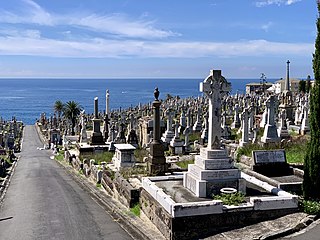
The Waverley Cemetery is a heritage-listed cemetery on top of the cliffs at Bronte in the eastern suburbs of Sydney, New South Wales, Australia. Opened in 1877 and built by R. Watkins and P. Beddie, the cemetery is noted for its largely intact Victorian and Edwardian monuments. It is regularly cited as being one of the most beautiful cemeteries in the world. The cemetery contains the graves of many significant Australians including the poet Henry Lawson. Also known as General Cemetery Waverley, it was added to the New South Wales State Heritage Register on 28 October 2016.

The John F. Kennedy Eternal Flame is a presidential memorial at the gravesite of assassinated United States President John F. Kennedy, in Arlington National Cemetery in Virginia. This permanent site replaced a temporary grave and eternal flame used at the time of Kennedy's state funeral on November 25, 1963, three days after his assassination. The site was designed by architect John Carl Warnecke, a long-time friend of Kennedy. The permanent John F. Kennedy Eternal Flame grave site was consecrated and opened to the public on March 15, 1967.
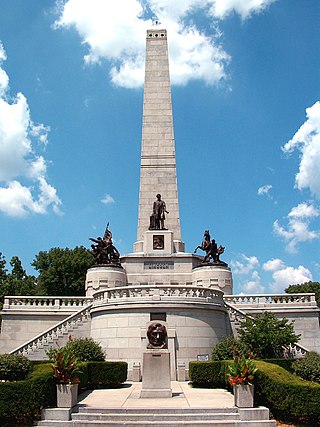
The Lincoln Tomb is the final resting place of Abraham Lincoln, the 16th president of the United States; his wife Mary Todd Lincoln; and three of their four sons: Edward, William, and Thomas. It is located in Oak Ridge Cemetery in Springfield, Illinois.
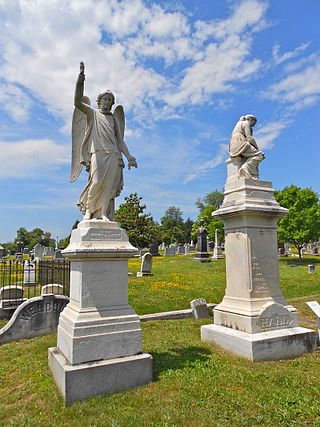
The Congressional Cemetery, officially Washington Parish Burial Ground, is a historic and active cemetery located at 1801 E Street, S.E., in Washington, D.C., on the west bank of the Anacostia River. It is the only American "cemetery of national memory" founded before the Civil War. Over 65,000 individuals are buried or memorialized at the cemetery, including many who helped form the nation and Washington, D.C. in the early 19th century.

The Harding Tomb is the burial location of the 29th President of the United States, Warren G. Harding and First Lady Florence Kling Harding. It is located in Marion, Ohio. Also known as the Harding Memorial, it was the last of the elaborate presidential tombs.

After Abraham Lincoln was assassinated on April 14, 1865, a three-week series of events was held to mourn the death and memorialize the life of the 16th president of the United States. Funeral services, a procession, and a lying in state were first held in Washington, D.C., then a funeral train transported Lincoln's remains 1,654 miles (2,662 km) through seven states for burial in Springfield, Illinois. Never exceeding 20 mph, the train made several stops in principal cities and state capitals for processions, orations, and additional lyings in state. Many Americans viewed the train along the route and participated in associated ceremonies.

Crown Hill Cemetery is a historic rural cemetery located at 700 West 38th Street in Indianapolis, Marion County, Indiana. The privately owned cemetery was established in 1863 at Strawberry Hill, whose summit was renamed "The Crown", a high point overlooking Indianapolis. It is approximately 2.8 miles (4.5 km) northwest of the city's center. Crown Hill was dedicated on June 1, 1864, and encompasses 555 acres (225 ha), making it the third largest non-governmental cemetery in the United States. Its grounds are based on the landscape designs of Pittsburgh landscape architect and cemetery superintendent John Chislett Sr and Prussian horticulturalist Adolph Strauch. In 1866, the U.S. government authorized a U.S. National Cemetery for Indianapolis. The 1.4-acre (0.57 ha) Crown Hill National Cemetery is located in Sections 9 and 10.
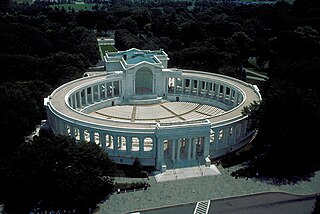
Memorial Amphitheater is an outdoor amphitheater, exhibit hall, and nonsectarian chapel located in Arlington National Cemetery in Arlington County, Virginia, in the United States. It was designed in 1913 as a replacement for the older, wooden amphitheater near Arlington House. Ground was broken for its construction in March 1915 and it was dedicated in May 1920. In the center of its eastern steps is the Tomb of the Unknown Soldier, dedicated in 1921. It has served as the site for numerous Veterans Day and Memorial Day events, as well as for memorial services and funerals for many individuals.

Natural burial is the interment of the body of a dead person in the soil in a manner that does not inhibit decomposition but allows the body to be naturally recycled. It is an alternative to typical contemporary Western burial methods and modern funerary customs.

Westview Cemetery, located in Atlanta, Georgia, is the largest civilian cemetery in the Southeastern United States, comprising more than 582 acres (2.36 km2), 50 percent of which is undeveloped. The cemetery includes the graves of more than 125,000 people and was added to the Georgia Register of Historic Places in 2019 and the National Register of Historic Places in 2020.

A burial vault is a structural stone or brick-lined underground tomb or 'burial chamber' for the interment of a single body or multiple bodies underground. The main difference between entombment in a subterranean vault and a traditional in-ground burial is that the coffin is not placed directly in the earth, but is placed in a burial chamber specially built for this purpose. A burial vault refers to an underground chamber, in contrast to an above-ground, freestanding mausoleum. These underground burial tombs were originally and are still often vaulted and usually have stone slab entrances. They are often privately owned and used for specific family or other groups, but usually stand beneath a public religious building, such as a church, or in a churchyard or cemetery. A crypt may be used as a burial vault and a freestanding mausoleum may contain a burial vault beneath the ground.

The James A. Garfield Memorial is a memorial for and the final resting place of assassinated President James A. Garfield, located in Lake View Cemetery in Cleveland, Ohio. The memorial, which began construction in October 1885 and was dedicated on May 30, 1890, exhibits a combination of Byzantine, Gothic, and Romanesque Revival architectural styles. Garfield, former First Lady Lucretia Garfield, and two other members of the Garfield family are entombed in the crypt level of the monument.

The English coastal city of Brighton and Hove, made up of the formerly separate Boroughs of Brighton and Hove in East Sussex, has a wide range of cemeteries throughout its urban area. Many were established in the mid-19th century, a time in which the Victorian "cult of death" encouraged extravagant, expensive memorials set in carefully cultivated landscapes which were even recommended as tourist attractions. Some of the largest, such as the Extra Mural Cemetery and the Brighton and Preston Cemetery, were set in particularly impressive natural landscapes. Brighton and Hove City Council, the local authority responsible for public services in the city, manages seven cemeteries, one of which also has the city's main crematorium. An eighth cemetery and a second crematorium are owned by a private company. Many cemeteries are full and no longer accept new burials. The council maintains administrative offices and a mortuary at the Woodvale Cemetery, and employs a coroner and support staff.
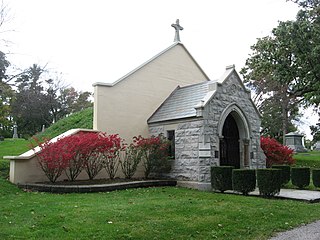
A receiving vault or receiving tomb, sometimes also known as a public vault, is a structure designed to temporarily store dead bodies in winter months when the ground is too frozen to dig a permanent grave in a cemetery. Technological advancements in excavation, embalming, and refrigeration have rendered the receiving vault obsolete.

The Public Vault at the Congressional Cemetery in Washington, D.C. is an early classical revival structure built 1832–1834 with funds appropriated by the United States Congress to store the bodies of government officials and members of the public before burial. About 4,600 individuals were temporarily interred in the vault, including three U.S. presidents, First Lady Dolley Madison, and sixteen congressmen who died while serving in office.

The Historic Cemeteries of New Orleans, New Orleans, United States, are a group of forty-two cemeteries that are historically and culturally significant. These are distinct from most cemeteries commonly located in the United States in that they are an amalgam of the French, Spanish, and Caribbean historical influences on the city of New Orleans in addition to limitations resulting from the city's high water table. The cemeteries reflect the ethnic, religious, and socio-economic heritages of the city. Architecturally, they are predominantly above ground tombs, family tombs, civic association tombs, and wall vaults, often in neo-classical design and laid out in regular patterns similar to city streets. They are at times referred to colloquially as “Cities of the Dead”, and some of the historic cemeteries are tourist destinations.





















